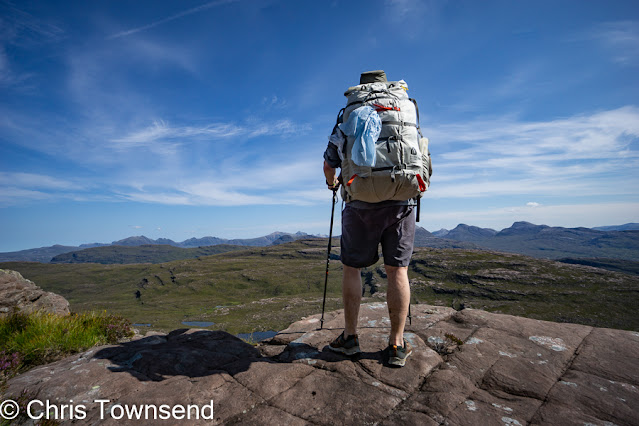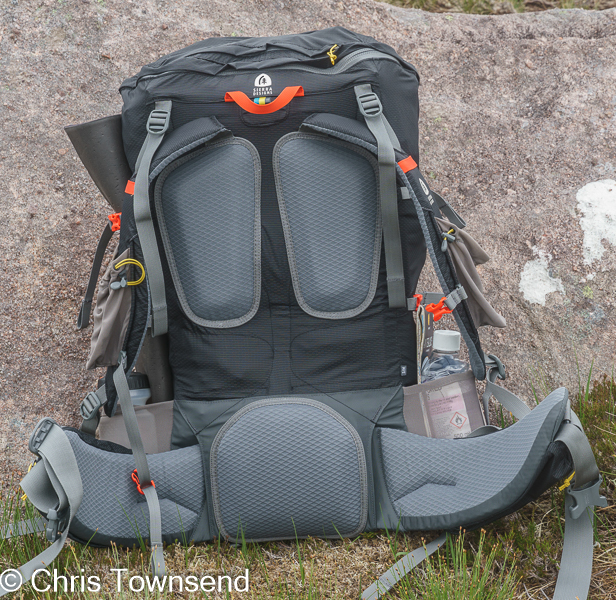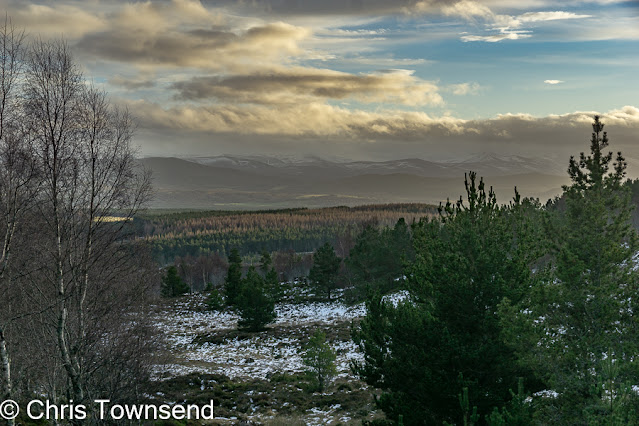 |
The North Face Back Magic II, Pacific Crest Trail, 1982
|
This is an updated feature that first appeared in 2018. I've made some edits, added some new words, a new pack, and a few different pictures.
Thinking about the packs I’ve used over the years,
especially on long-distance walks, I realised that the big change has been in
capacity and weight – as gear in general has got more compact and lighter so
have the packs I use. However, despite all the developments in materials and
designs the packs I used over forty years ago would be fine today. Over the
years I’ve gone from external frame to internal frame to, briefly, frameless
and back to internal frame. Here’s a run-down of the key packs.
After a couple of poor choices when I started backpacking –
a cheap external frame that broke and a better quality one with no hipbelt and
a difficult to use packbag – my first good pack was the Camp Trails Ponderosa,
which came with an external frame called the Astral Cruiser. I bought this
because it was recommended in the first backpacking books I read, Teach Yourself Backpacking by Peter
Lumley and The Backpacker’s Handbook
by Derrick Booth (much later I pinched the last title for one of my books). The
Ponderosa was a classic external frame pack of the time. In 1976 I used it on
my first walk longer than a weekend, the Pennine Way, and found it a little
unstable on rough terrain though very comfortable on good paths. However, the
hipbelt ripped off towards the end of the trip and I had to sew it back on.
 |
Berghaus Cyclops Scorpion, Pacific Crest Trail, 1982
|
That failure meant I wanted a new pack for my first really
long walk two years later, Land’s End to John O’Groats. Berghaus, then still a
fairly new company, had recently launched their internal frame Cyclops pack and
they looked tough, so I picked one of these, the 80 litre Serac. This proved
comfortable and survived the walk so for my next long trip, the Pacific Crest
Trail in 1982, I went for a bigger Cyclops model, the 100 litre Scorpion,
reckoning I’d need the extra capacity. I did and could have done with more. At
one point I carried my heaviest every load – 23 days supplies plus ice axe,
crampons, snowshoes, and extra clothing. The pack almost disappeared under all
the gear on the outside.
 |
The ridiculously heavy load, Pacific Crest Trail, 1982
|
The Scorpion performed well but after around 1500 miles the
frame snapped – probably weakened when I let it bounce down a steep snowy pass
in the High Sierra. As the frame was sewn-in to the padded back and was an
unusual asymmetric X shape I couldn’t replace it. Unable to find an internal
frame pack big enough I replaced it with an external frame one, The North Face
Back Magic II. This had an equally unusual frame, an asymmetric hour-glass
shape. It handled the last 1000 miles of the PCT fine but developed a slight
bend in the frame on the airplane on the way home. I still have it. Maybe I’ll
try it again soon.
 |
The North Face Back Magic II, Pacific Crest Trail, 1982
|
Next came my 1985 Continental Divide Trail walk. After the
broken Cyclops frame I looked for a different internal frame one and ended up
with the Karrimor Condor 60-100, another huge pack with the biggest side
pockets I’ve ever seen. This lasted around 2000 miles and then one of the
shoulder straps snapped. It had rubbed against the hard plastic reinforcement
in the hipbelt and slowly weakened – if I’d spotted this I could have padded
it. After that I checked packs more often. I replaced it with an even bigger
125 litre Gregory Cassin, bought because it was recommended by Colin Fletcher
in the latest edition of The Complete
Walker. It was very heavy but also the most comfortable pack I’d yet used.
 |
Karrimor Condor 60-100, Continental Divide Trail, 1985
|
I went back to the Karrimor Condor 60-100 for my 1988 walk
the length of the Canadian Rockies but the hipbelt design had changed and I couldn’t
get it comfortable – I obviously hadn’t tested it at home adequately. By this
time I was reviewing packs for magazines and so had quite a choice of models.
Lowe Alpine, who’d invented the internal frame pack, had sent me a prototype
for their first external frame model called the Holloflex. This had the most
massive padded hipbelt I’d ever seen plus a plastic frame that was said to be
extremely tough. With sore hips from the Condor I fancied that hipbelt and had
the pack sent out to me. It did prove superbly comfortable but the hipbelt
began to part from the frame towards the end of the walk and ended up being
held on with duct tape. The Holloflex never went into production due to the
costs. It was the last time I used an external frame on a long walk.
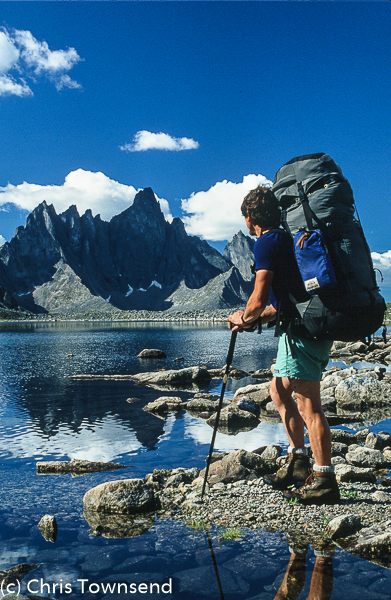 |
Gregory Cassin, Yukon Territory, 1990
|
Two years later I went back to the Gregory Cassin for a walk
the length of the Yukon Territory and again it was fine though by the end of
that trek it was looking rather worn so I decided it wasn’t up to another long
walk. By this time New Zealand company Macpac had arrived in the UK and their
packs, made from a canvas like polyester/cotton fabric, looked really tough so
I took the 90 litre Cascade on a 1992 walk the length of the Scandinavian
mountains. Most of the way it was fine but towards the end of the walk the
buckles on the hipbelt and shoulder straps started slipping annoyingly often.
 | | |
Dana Designs Astralplane, Cairngorms, 2021
|
During the 1990s I led many ski tours, including camping
expeditions to places like Greenland, Spitsbergen, the Yukon Territory, and the
High Sierra. For this I needed a monster pack that was very stable as well as
comfortable. A bit of research and I discovered the 115 litre Dana Designs
Astralplane. I bought one and it was superb, the most stable huge pack I’ve
ever tried. It proved very tough too. Indeed, I still have it and it’s in fine
condition. I’ve never used it on a long-distance walk, however. I did take it
on a two-week walk in Yosemite National Park in 1995 and have used it a few
times for one and two night trips with bulky gear I’m testing, most recently in
December 2021. It's indestructible.
 |
Aarn Natural Balance, Munros & Tops, 1996
|
The packs above all weighed in the 2.5 -3.5kg range. That’s
heavy. The ultralight gear revolution had begun in the early 90s and there were
now frameless packs that weighed less a kilo. I didn’t find them comfortable
with more than a very light load. For my next walk I did want a lighter pack
though. Climbing all the Munros and Tops in one walk meant far more ascent than
on any previous long-distance walk so I wanted to keep my load as light as
possible whilst still being comfortable and functional. I tried a few of the
new lighter packs but wasn't convinced by any of them. Then Aarn Tate asked me
to try some prototype Natural Balance lightweight packs. As I’d be able to
change packs quite easily this being a walk at home rather than abroad, I
agreed and ended up using several models in the 65-75 litre range. When these
packs were being shuttled around I used a 70 litre Lowe Alpine Alpamayo, which
was fine, or an Arc’teryx Bora 60, which was very comfortable but unstable when
scrambling as I discovered on the Aonach Eagach. This was the only walk I
intentionally planned on using several packs though as I’ve shown above having
one pack last a whole walk was rare.
 |
Gregory Shasta, Arizona Trail, 2000
|
Whilst the Aarn packs were good with medium loads I needed
one that would handle much more for the Arizona Trail, which I walked in 2000,
as I knew I’d be carrying large quantities of water at times. Still not
convinced by lightweight packs I returned to Gregory and the 82 litre Shasta,
which survived the walk and carried the weight well.
 |
GoLite Pinnacle, Pacific Northwest Trail, 2010
|
During the first decade of this century the development of
lightweight packs moved fast and soon there was quite a choice of models that
would handle quite heavy loads. Having used one of the lightest ones, the
GoLite Pinnacle, on several two-week TGO Challenge crossings of the Scottish
Highlands I decided on one of these for the Pacific Northwest Trail, which I
walked in 2010. The 72 litre Pinnacle had no frame, just a lightly padded back,
and a fairly minimalist hipbelt. However, the curved shape meant it was
surprisingly comfortable. The PNT was too much for it though. After three weeks
the shoulder straps began to deform and feel uncomfortable. Holes started to
appear in the fabric too. GoLite replaced it with the heavier though still
lightweight Quest which had a frame, and which was excellent for the rest of
the walk. I reckon the Pinnacle was probably a rogue model that had slipped
through quality control.
 |
GoLite Quest, Pacific Northwest Trail, 2010
|
Whatever the reason for the failure I decided that my
experiment with frameless packs for long walks was over. The comfort of the
Quest, which was still far lighter than the packs I’d been using not many years
before, was a key factor in this.
 |
Lightwave Ultrahike, Scottish Watershed, 2013
|
In 2013 I chose the internal frame 1.23kg 60
litre Lightwave Ultrahike for the Scottish Watershed, partly because it was far
more water-resistant than most packs and I thought the walk could be quite wet,
as indeed it was. The Ultrahike was excellent, but the shape wasn’t right for
my next walk. In 2016 I walked 500 miles from Yosemite Valley to Death Valley
with an internal frame ULA Catalyst pack because I could fit a bear-resistant
canister in the top, which I couldn’t do in the Ultrahike. I carried heavier
loads than recommended in this pack – I had eleven litres of water at one point
in the desert – and it was fine.
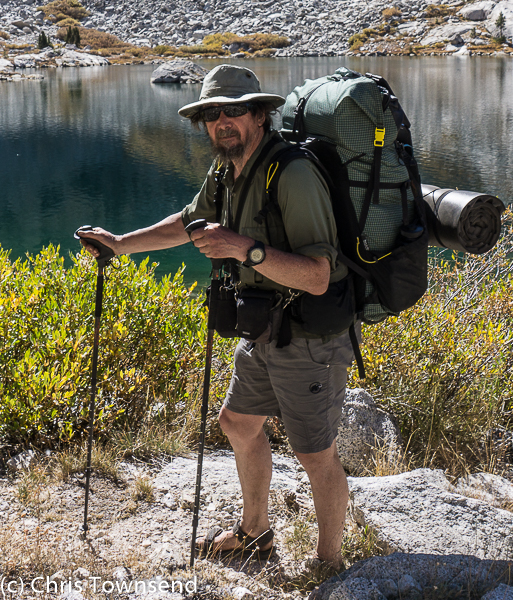 |
ULA Catalyst, Yosemite Valley to Death Valley, 2016
|
I’d planned on using the 1.4kg Catalyst on my next long walk
– it is one of my favourite packs – until I was offered a much lighter pack to
test, the 60 litre internal frame Gossamer Gear Mariposa, which weighs 945
grams and handles 15kg loads well. After some initial testing I really liked
the design and the comfort, so I took the Mariposa on the GR5 Through the Alps
walk from Lake Geneva to the Mediterranean Sea and was really pleased with it.
I loved the massive pockets in particular. I then took the Mariposa on the
fortieth TGO Challenge in 2019. Unfortunately, one of the load lifter straps
ripped out and whilst I managed without it, the pack wasn't as comfortable.
 |
Gossamer Gear Mariposa, GR5 Through the Alps, 2018
|
My next long walk was on the southern part of the
Continental Divide Trail in Colorado, a section where I'd been forced by snow
and storms to take a lower route in 1985. On this I took another new test pack,
the 1.2kg internal frame Sierra Designs Flex Capacitor 40-60, which proved
comfortable and stable. I did miss having a front pocket but discovered that
the flat zipped lid meant I could lay out gear in the top of the pack and have
quick access to it. I did overload the pack with ten days food at one point and
the hipbelt did slip a little under the extra weight but with five to six days
food it was fine.
 |
Sierra Designs Flex Capacitor, Colorado Rockies, 2019
|
My final words on this piece were “for my next walk?
Probably the Catalyst, Mariposa (which is away being repaired), or the Flex
Capacitor. Unless, of course, a new pack arrives to test that I like.” Well,
one did arrive last autumn, the 925 gram Atom Packs The Mo EP 50 (review here)
and I may well use this, though more likely the 60 litre version.
 |
Atom Packs The Mo EP50, Cairngorms, 2021
|




